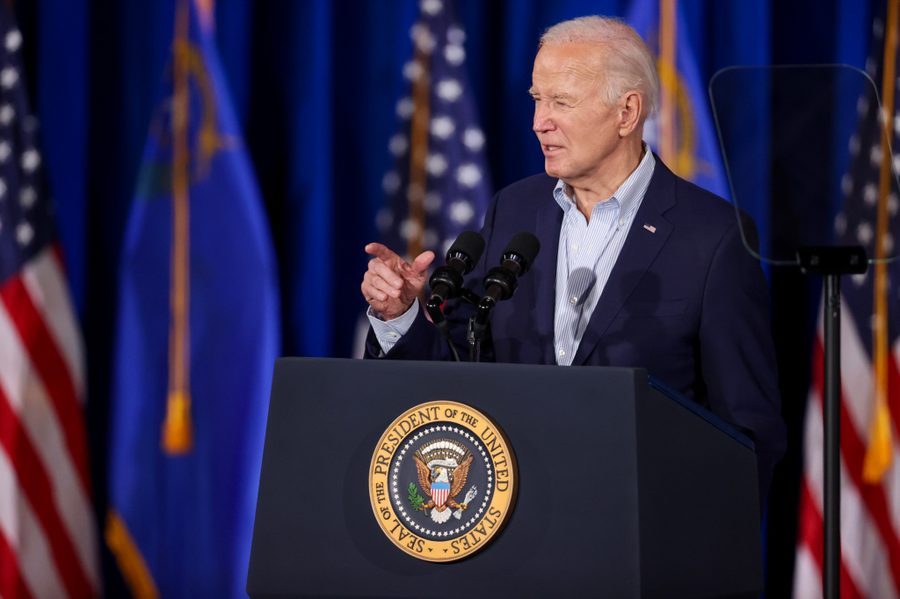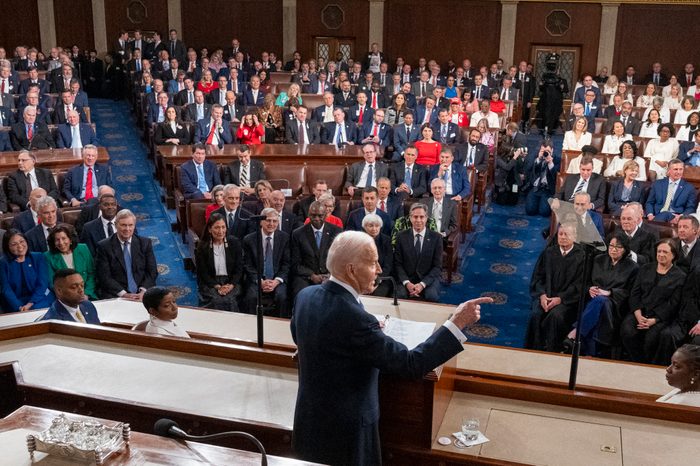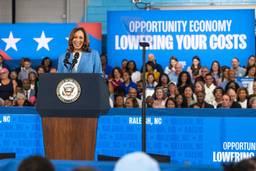Unpacking Biden’s Second Term Economic Plan
The Biden administration’s proposed 2025 budget marks a departure for Democratic incumbents.
Max B. Sawicky

President Joe Biden’s State of the Union speech and his recently released 2025 budget provide a window into how Democrats will run this year. Campaign promises may not carry a lot of weight, but in light of Biden’s domestic record when Democrats held razor-thin majorities in Congress in 2021 and 2022, perhaps they should. During those first two years in office, Biden and his party managed to break through Republican intransigence and enact consequential legislation that provided families with relief from the recession and broke new ground in combatting climate change. The most credible promises are those that can point to previous successes.
On the anti-recession front, the American Rescue Plan provided direct payments of $1,400 per person, expanded unemployment compensation, and a temporary expansion of the Child Tax Credit that was worth as much as $2,000 per qualifying child, among a myriad of new spending measures in the $1.9 trillion bill.
Regarding climate change, the Inflation Reduction Act funded $390 billion worth of projects aimed at reducing CO2 emissions and building out clean energy infrastructure.
And the “CHIPS Act” took steps to reverse the erosion of well-paying manufacturing jobs from the United States, effectively breaking the long-standing political obstacles to the pursuit of industrial policy.
The public’s awareness of these accomplishments may be lacking, but they all provide ammunition for this year’s campaign and their enactment promises more to come.
On top of the legislative victories, the Biden administration can tout the economy’s recovery from the Covid recession, including spectacular growth in employment, historic lows in the unemployment rate, increases in real wages, and a dramatic slow-down in inflation. It won’t hurt the Democrats’ political prospects that the stock market has also been popping since last fall, though the benefits of that boom for the bulk of the population are limited. It helps that the U.S. recovery compares favorably to those in other advanced industrial nations.
Despite these successes, many Americans say they are struggling with higher costs, including prices of groceries and housing, and the country is seeing a rise in food insecurity and homelessness which is most impacting those at the lower end of the income ladder. These are challenges, but helping solve them requires more aggressive social spending and fiscal policy, not less.
Good policy is good politics, and there is little of either in the GOP’s right-wing agenda. Among other dubious ventures, Republicans will be running against Social Security, Medicare, and reproductive rights, even if they try to pretend otherwise. Former president and Republican nominee Donald Trump himself was recently forced to walk back typically careless musings about cutting entitlements, while many Republicans are back-peddling as fast as they can on their advocacy of abortion bans.
As it stands, the GOP majority in the House allows for no advances of any sort in public policy. We needn’t linger on the absence of promises from the Trump camp, other than chronicles of doom foretold for political enemies, immigrants, LGBTQ persons, and people of color, but here the vacuum of substance will also reflect poorly on conservatives in down-ballot races for Congress.
Last week, the Biden administration released its 2025 budget, laying out economic priorities for a second term. In one sense it is premature to speak of next year’s budget. The federal government is presently running on funding from continuing resolutions that expire later this month. Jousting over extensions is complicated by the Republican House Speaker Mike Johnson’s weak grip on power, and by the grace of the most far-right members of Congress. Intra-MAGA squabbling will further cloud the GOP’s efforts to promote its own policy alternatives, which feature tax cuts, deregulation and purging the federal civil service.
The crucial source of domestic policy activism in Biden State of the Union and his budget plan is the increase of taxes on corporations and the rich, totaling about $5 trillion over the next decade. These include raising the corporate tax rate from 21% to 28% (which is still lower than the 35% it was before Trump’s tax cuts), adding a new minimum corporate tax and raising a tax on stock buybacks fourfold. This approach is a two-edged sword.
On the plus side is the willingness to pose revenue raising as a class issue: redistribute from the well-off to the public at large. This theme is emphasized by Biden’s commitment to renew the expanded Child Tax Credit, which was shown to have an enormous impact in reducing child poverty in 2021, and to create a national paid leave program for U.S. workers.
The downsides of this approach are twofold. One is the implied need to have domestic spending growth financed by “pay-fors,” even progressive ones such as taxing the wealthy. Biden has helped lead the Democrats away from deficit mania, but as with other “zombie ideas” in economics, the mantra never entirely dies out.
The other is the embrace of promises to not increase taxes on households with less than $400,000 in annual income. This last pledge is why, ultimately, we can’t have too many nice things from Democrats as presently constituted. Much greater spending could be supported on the strength of its net benefits.
Even after factoring in higher taxes on a broader swath of Americans, a build-out of the welfare state would benefit the vast majority of the population. It’s the difference between liberalism and social-democracy. A successful electoral result for Democrats this year, followed by implementation of the policies in the speech and growth in the party’s left flank, could set the stage for bigger and better advances in the future: Medicare for All and free college, for instance. We could also do much more to mitigate climate change — in that area, it’s hard to imagine doing too much.

In Biden’s State of the Union, he also laid out how new spending would be devoted to less appealing areas such as the bulking up of border enforcement personnel. The security side of immigration dominated the border deal that Democrats recently reached with Senate Republicans. We might thank Trump for his role in blowing up this deal because, with a fully Democratic Congress, a much better and more humane immigration plan could be achieved, potentially including increased support for the Dreamers. With Trump in the White House, a hellscape will be on the agenda for immigrants no matter what Congress does this year.
But Democrats would be smart to take a cue from recent data from the Congressional Budget Office which illustrates how immigration is expanding the economy. The negative impact on the labor force level from an aging population is more than offset by the addition of prime-age, foreign-born workers. From a narrow economic standpoint, more people are good for the nation. Among other things, people are a resource (not to mention humans deserving of dignity). We certainly acknowledge that about babies born in the United States. The fact that, for certain Americans, views differ according to the ethnicity of additions to the population speaks for itself.
Many of Biden’s proposals do not hinge on new spending in particular, instead turning to tax credits. The credits can have just as much impact on the deficit as spending but they are generally easier to swallow for a public not yet fully weaned from deficit phobias. Some examples from the president’s proposed budget include credits making it easier to build and afford housing, and making credits for healthcare related to the Affordable Care Act permanent.
Some rule changes also have impacts on the deficit, such as the effort to lower prescription drug prices. The hot air in drug prices is a major contributing factor to the unaffordability of healthcare in the United States and the bloat in Medicare and Medicaid spending. To this end, Biden has sought to empower Medicare to negotiate lower drug prices and cap the price of insulin for seniors at $35 per month, and is promising to go further.
More spending can also save money. An important example is the Biden administration’s increase in funding for the Internal Revenue Service, which brings in far more delinquent taxes owed than the cost of retrieving these funds.
Rejuvenation of the civil service in agencies such as the National Labor Relations Board (NLRB), the Federal Trade Commission, and the Consumer Financial Protection Bureau have little impact on spending totals but potentially great benefits for workers and consumers. While proposed funding levels for the NLRB and Department of Labor could be higher, that fact the administration values investing in them marks a clear difference with Republicans who would rather see the agencies starve. Also noteworthy is the increased activism under the Biden administration in the field of anti-trust at the Department of Justice. The Republicans, meanwhile, are making clear their hopes to sweep out the federal civil service and staff government agencies with political lackeys who can be removed at will.
By comparison with Democratic predecessors and inside greatly diminished political space, Biden has staked out new ground. For example, Biden walked the picket line alongside the United Auto Workers during the union’s strike against the Big Three automakers last year, whereas former President Barack Obama twiddled his thumbs during the public employee uprising in Wisconsin in 2011. And while Democratic incumbents have tended to tack to the right on economic policy during their re-election campaigns, judging by his budget proposals, Biden is so far resisting that tendency and instead leaning into the use of government to help solve social ills.
Biden’s political fortunes are of course beset by his administration’s position of uncritical support for Israel’s war crimes in Gaza and the West Bank, which are hurting him among key constituencies. Meanwhile, funding for Ukraine remains mired in Congress, though some pressure is building on Republicans to support it. A Trump presidency promises more brutality when it comes to U.S. foreign policy, not to mention on the domestic front. When it comes to his economic plans, Biden’s agenda is not too ambitious for the moment.
Max B. Sawicky is an economist and writer in Virginia, formerly with the Government Accountability Office and the Economic Policy Institute. He is a Senior Research Fellow at the Center for Economic and Policy Research and runs the MaxSpeak, You Listen! blog at sawicky.substack.com.








